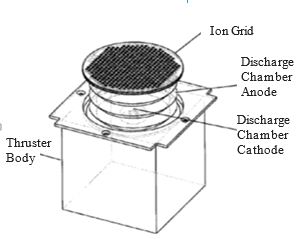Inventors at Georgia Tech have developed a mechanical method to store a high-performance gridded ion thruster in a small volume compatible with the dimensions of a small (cubesat/nanosat) spacecraft for efficient storage during launch to orbit. Once the spacecraft is ejected from the launch vehicle, the gridded ion thruster is deployed to its full operational geometry and physical size. The small volume of the deployable chamber frees up volume for fuel. Deploying a large ion thruster whose physical dimensions are larger than the platform of a cubesat is advantageous for two reasons. First, the large size of the deployed gridded ion thruster creates a large internal volume-to-surface area ratio in the plasma chamber of the gridded ion thruster, which enables efficient propulsion ionization and high propellant utilization. Second, it creates the required surface area for the thruster to passively cool itself via radiation to the space environment.The design concept for storage and deployment involves the use of elastic, lightweight, multifunctional tiles that are folded and wrapped using slipping folds.
- Enables efficient ion thruster propulsion capability for cubesats
- Deploys large surface area gridded ion thruster from small stowed internal volume
- Enables, via large deployed size, efficient propellant ionization, high propellant utilization, and passive cooling
- Frees up space for fuel and payload
- Enables high specific-impulse station-keeping and orbit-transfer capabilities for cubesats
- Sufficiently-powered cubesats to perform large delta-V maneuvers
- Transfers to other space bodies, the moon in particular
With the continuing miniaturization of satellite components, small nano- and pico-satellites such as cubesats are growing in importance. Ion thrusters are proven, reliable propulsion systems with high specific impulse, which makes them superior to chemical propulsion systems for long-duration station-keeping and large orbit transfers. However, power and space limitations in small satellites presently constrain the use of ion thrusters, thereby necessitating the use of chemical propulsion systems.

